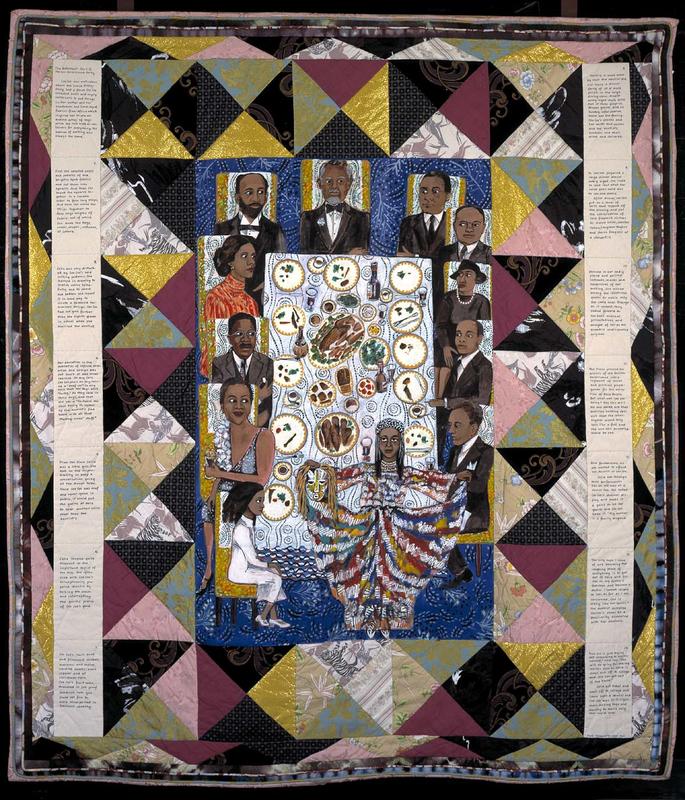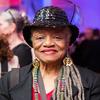More about The Bitter Nest, Part II: The Harlem Renaissance Party

Sr. Contributor
Faith Ringgold called The Bitter Nest “a fantasized adaptation of real life.”
In this story quilt you see a glimpse of the costumes she wore when she originally told this story as a performance piece.
The Bitter Nest focuses on a girl named Celia and her strained relationship with her mother CeeCee, which echoed Ringgold’s own difficulties in connecting with her daughters. Ringgold’s story quilts were often semi-autobiographical, for example, The French Collection drew from her struggles as an artist. This piece, The Bitter Nest Part II: The Harlem Renaissance Party is only a slice of a narrative, the second in a five part series. When Ringgold performed this story, she remained silent, performing a pantomime to a prerecorded narration in her voice. The only stage props were ten quilt bags.
For context, The Bitter Nest Part I: Love in the School Yard dives into CeeCee’s backstory. She meets Celia’s future father Dr. Prince when she drops her school books in front of him. She’s fourteen, he's forty four. When she gets pregnant, they marry and CeeCee drops out of school. But when Celia comes into the world, CeeCee becomes deaf and no longer speaks.
None of these big life changes truly dampens CeeCee’s creative spirit or her expression of it. She is always sewing, drapes, costumes, but most of all bags, convinced there was a bag for everything. She always arranges the clashing colors however she sees fit. As Celia puts it within the text of this quilt, CeeCee “turned a ‘deaf ear’ to any talk that her bags were tacky.”
In this quilt, Celia is horribly embarrassed because CeeCee has a habit of performing at their very frequent dinner parties. This particular party has a few famous cameos such as Langston Hughes and Alain Locke. The text of this quilt ends on a note describing CeeCee as “still dancing to music only she could hear” even after Celia has left for college to become a doctor.
If you’re curious where the story goes from there, I highly recommend reading the quilts in full, as there are so many subtleties and nuances in Ringgold’s writing that any attempt to briefly summarize it here wouldn’t translate it properly. But, I will say that there’s a bittersweet ending for the mother and daughter pair.
Sources
- Antoniou, Antonis, and Steven Heller. Decoding Manhattan Island of Diagrams, Maps, and Graphics. New York: Abrams, 2021.
- “The Bitter Nest Part V: The Homecoming .” Currier Museum of Art . Accessed September 16, 2022. http://collections.currier.org/objects-1/info?query=Portfolios+%3D+%226….
- “The Bitter Nest, Part II: The Harlem Renaissance Party.” Smithsonian American Art Museum. Accessed September 16, 2022. https://americanart.si.edu/artwork/bitter-nest-part-ii-harlem-renaissan….
- Cameron, Dan. Dancing at the Louvre: Faith Ringgold's French Collection and Other Story Quilts: Exhibitions: Akron, Akron Art Museum, January 24 - March 22, 1998 ... New York: New Museum of Contemporary Art, 1998.
- Farrington, Lisa E., and Faith Ringgold. Faith Ringgold. San Francisco: Pomegranate, 2004.
- Gage, Simone. "Faith Ringgold's French Collection: Jo Baker's Birthday." Shifting Perspectives. December 02, 2020. Accessed September 18, 2022. https://mcam.mills.edu/publications/shiftingperspectives/catalogue/simo….
- Ringgold, Faith. “The Bitter Nest Part I: Love in the School Yard.” Acrylic on fabric. 1988. de Young museum, Faith Ringgold: American People exhibition.











